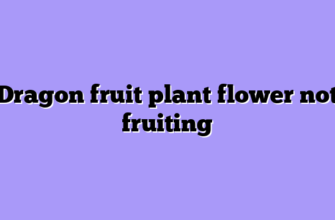Dragon fruit is a unique and delicious fruit that is native to Central and South America. It is a popular fruit in many parts of the world, and it is becoming increasingly popular in the United States. If you are interested in growing dragon fruit, you will need to know how to pollinate it.
Pollination is the process of transferring pollen from the male part of the flower to the female part of the flower, which is necessary for the fruit to develop. In this guide, we will discuss the steps you need to take to successfully pollinate dragon fruit.
My Journey: A Step-by-Step Guide to Pollinating Dragon Fruit
As a passionate dragon fruit enthusiast, I’ve delved deep into the art of pollination, unlocking the secrets to bountiful harvests and vibrant blooms. Join me on this journey as I share my step-by-step guide to pollinating dragon fruit.
Step 1: Understanding the Basics Before diving into the pollination process, it’s crucial to grasp the fundamentals of dragon fruit biology. Dragon fruit, also known as pitaya, is a tropical fruit that blooms at night. It typically requires cross-pollination to produce fruit, as its flowers contain both male and female reproductive organs but often mature at different times.
Step 2: Identifying the Flowers Dragon fruit flowers are stunningly beautiful, with large, white petals that open only at night. To pollinate effectively, you need to identify the flowers that are ready for action. Look for flowers that have just opened or are about to open fully. These are the prime candidates for pollination.
Step 3: Gather Your Tools For successful pollination, you’ll need a few simple tools:
- A small, soft paintbrush or cotton swab
- A headlamp or flashlight (since dragon fruit flowers bloom at night)
- Optionally, a ladder if your dragon fruit plants are tall
Step 4: Preparing for Pollination As night falls and the dragon fruit flowers begin to open, equip yourself with your headlamp or flashlight. Approach the plants gently, being careful not to disturb them. Take a moment to observe the flowers and select those that are fully open and receptive to pollination.
Step 5: Pollination Process Using your paintbrush or cotton swab, carefully transfer pollen from the stamen (male reproductive organ) of one flower to the stigma (female reproductive organ) of another. Be gentle to avoid damaging the delicate flower structures. Repeat this process for several flowers to ensure thorough pollination.
Step 6: Encouraging Fruit Formation After pollination, monitor the flowers closely for signs of fruit development. With successful pollination, you should start to see small fruit begin to form at the base of the pollinated flowers within a few weeks. Continue to care for your dragon fruit plants by providing adequate water, sunlight, and nutrients to support healthy fruit growth.
Step 7: Harvesting the Fruits As the dragon fruit matures, it will gradually change color and develop a slightly soft texture. Once ripe, carefully harvest the fruits using pruning shears or a sharp knife, taking care to avoid damaging the plant. Enjoy the fruits of your labor fresh or incorporate them into delicious recipes.
Step 8: Celebrate Your Success Congratulations! You’ve successfully pollinated your dragon fruit plants and reaped the rewards of your efforts. Take a moment to celebrate your green thumb skills and the joy of growing your own delicious dragon fruit.
In conclusion, pollinating dragon fruit is a rewarding experience that allows you to play an active role in the growth and development of these exotic fruits. With patience, care, and a little bit of know-how, you can enjoy a bountiful harvest of homegrown dragon fruit for years to come. Happy pollinating!
The Benefits of Pollinating Dragon Fruit: Why It’s Important
Dragon fruit, also known as pitaya, is a tropical fruit that is native to Central and South America. It is a popular and nutritious food that is gaining popularity around the world. The fruit is high in fiber, vitamins, and minerals, and is a great source of antioxidants. It is also low in calories and fat, making it a great choice for those looking to maintain a healthy diet.
However, the benefits of dragon fruit extend beyond its nutritional value. The plant is also an important pollinator, providing essential services to the environment. Pollination is the process by which plants reproduce, and it is essential for the health of ecosystems. Without pollinators, many plants would not be able to reproduce and would eventually die out.
Dragon fruit is a great pollinator because it is a large, showy flower that attracts a variety of pollinators. The flowers are usually white or pink and have a sweet scent that attracts bees, butterflies, and other insects. These pollinators then transfer pollen from one flower to another, allowing the plant to reproduce.
The benefits of pollinating dragon fruit are numerous. By providing a food source for pollinators, dragon fruit helps to maintain healthy populations of bees, butterflies, and other beneficial insects. These insects are essential for the health of ecosystems, as they help to pollinate other plants and provide food for other animals.
In addition, dragon fruit helps to maintain genetic diversity in plants. By transferring pollen from one flower to another, the plant is able to produce offspring with different genetic traits. This helps to ensure that the plant is able to adapt to changing environmental conditions and remain healthy.
Finally, dragon fruit helps to maintain the beauty of the environment. The large, showy flowers of the plant provide a colorful addition to any landscape. This can help to attract more pollinators and other beneficial insects, as well as providing a pleasant aesthetic to the area.
In conclusion, dragon fruit is an important pollinator that provides numerous benefits to the environment. By providing a food source for pollinators, maintaining genetic diversity, and adding beauty to the landscape, dragon fruit is an essential part of any healthy ecosystem.
How to Identify Male and Female Dragon Fruit Flowers
The first step in identifying the gender of a dragon fruit flower is to look at the shape of the flower. Male dragon fruit flowers are typically bell-shaped, while female flowers are more open and star-shaped. Male flowers also tend to be smaller than female flowers.
The next step is to look at the color of the flower. Male dragon fruit flowers are usually white or yellow, while female flowers are typically pink or red. Male flowers also tend to have more petals than female flowers.
Finally, you can look at the stamens of the flower. Male dragon fruit flowers have long, thin stamens, while female flowers have shorter, thicker stamens.
By looking at the shape, color, and stamens of a dragon fruit flower, it is possible to identify the gender of the flower. Knowing the gender of the flower can help you determine which flowers are likely to produce fruit.
The Best Time of Year to Pollinate Dragon Fruit
Pollination is an important part of the dragon fruit growing process, and the best time of year to pollinate dragon fruit depends on the climate and growing conditions of the area.
In areas with a warm climate, such as Central and South America, the best time to pollinate dragon fruit is during the spring and summer months. During this time, the temperatures are warm enough to encourage the growth of flowers and the pollination process. The flowers of the dragon fruit plant are typically white or pink in color and have a sweet, fragrant smell. The flowers are pollinated by bees, which are attracted to the sweet scent.

No matter what climate you live in, it is important to ensure that the dragon fruit plants are well-watered and receive plenty of sunlight. This will help to ensure that the flowers bloom and the pollination process is successful. Additionally, it is important to keep the plants free from pests and diseases, as this can interfere with the pollination process.
In conclusion, the best time of year to pollinate dragon fruit depends on the climate and growing conditions of the area. In areas with a warm climate, such as Central and South America, the best time to pollinate dragon fruit is during the spring and summer months. In areas with a cooler climate, such as the United States, the best time to pollinate dragon fruit is during the fall and winter months. No matter what climate you live in, it is important to ensure that the dragon fruit plants are well-watered and receive plenty of sunlight in order to ensure successful pollination.
Tips for Successfully Pollinating Dragon Fruit in Your Garden
- Choose the Right Variety: Dragon fruit plants come in several varieties, and some are better suited for pollination than others. Select a variety that is self-fertile or one that is compatible with other varieties in your garden.
- Plant in the Right Location: Dragon fruit plants need plenty of sunlight and well-draining soil. Plant your dragon fruit in an area that receives at least six hours of direct sunlight each day.
- Provide Support: Dragon fruit plants can grow up to 10 feet tall, so it is important to provide support for the vines. Use a trellis or other support structure to keep the vines off the ground.
- Hand Pollinate: Dragon fruit plants are not usually pollinated by bees or other insects, so you may need to hand pollinate the flowers. Use a small paintbrush to transfer pollen from the male flowers to the female flowers.
- Monitor for Pests: Dragon fruit plants are susceptible to pests such as aphids and mealybugs. Monitor your plants regularly and take steps to control any pests that you find.
- Harvest Carefully: When the dragon fruit is ripe, it will fall off the vine. Use a ladder or other tool to reach the fruit and harvest it carefully.
Conclusion
In conclusion, pollinating dragon fruit is a relatively simple process that can be done by hand or with the help of bees. Hand pollination is the most common method and involves using a small brush to transfer pollen from the male flower to the female flower. If bees are available, they can be used to pollinate the flowers as well. Regardless of the method used, pollinating dragon fruit is an important step in ensuring a successful harvest.








